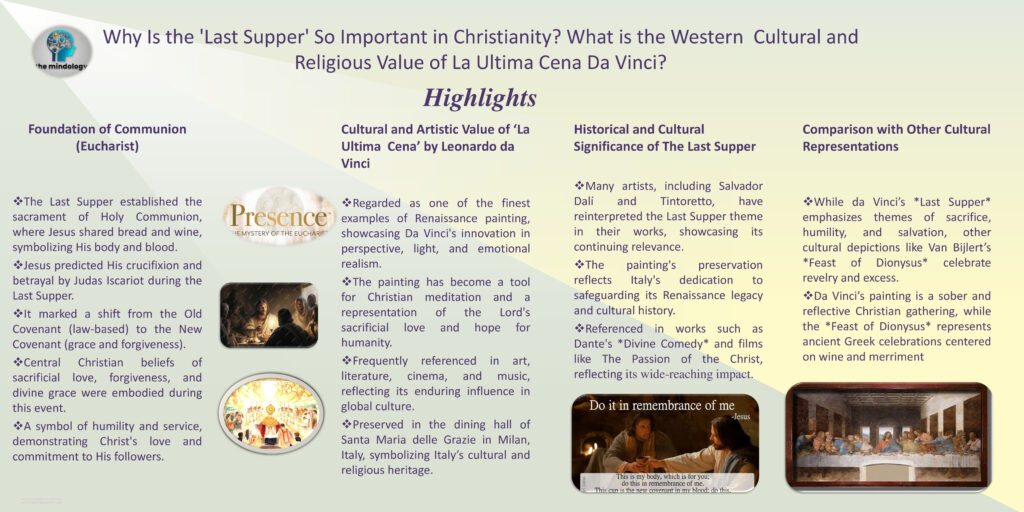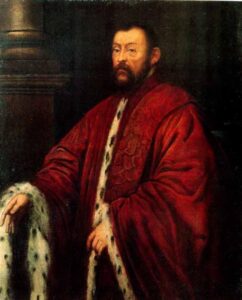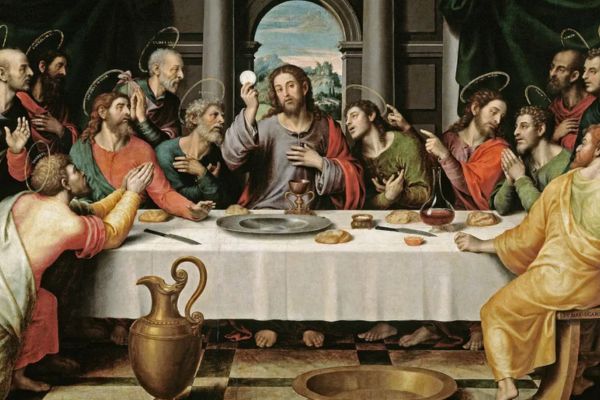The Last Supper in the Bible is an essential scripture in the Christian tradition. Apart from the last meeting of Jesus and his disciples, it also tells about the foundation of Communion and anticipates Christ’s death. The work contains essential ideas of Christianity, such as sacrificial love and forgiveness, which are of great importance to the faith.
Leonardo Da Vinci is often accredited for producing one of the best Renaissance paintings. ‘La Ultima Cena da Vinci‘ (Last Supper painting by Leonardo da Vinci) is in Santa Maria delle Grazie, Milan, Italy. The dynamic depiction of the characters across many generations characterizes the communion scriptures in the Bible.
The Last Supper scripture and murals have been symbols of Western civilization art, which has led many artists to invest in this scene. They have also been used in the craft works of literature, film, and even music, proving the relevance of this standard for generations. The survival and restoration of the painting also tell of Italy’s eagerness to safeguard its cultural heritage.
The blog delves into the significance of the Last Supper scripture in the Bible and its depiction in ‘La Ultima Cena da Vinci’ with unique touches on its religious content, novel artistic interpretation approaches, and prominence in Western society.

Why Is the 'Last Supper' Scripture So Important in Christianity? Historical Perspective
The Last Supper is the originating point of the Eucharist, the Holy Sacrament in Christianity. It is a remembrance of the Lord’s Supper in the Bible. In the present context, Jesus took bread and wine and created a great act of compassion and demonstration of Christ which, in His love, would sustain, welcoming His followers into his sacrificial love.
The New Covenant (promise that God will forgive sin and restore fellowship) during the Last Supper superseded the Old Covenant (external regulations applying until the time of the new order). This was a significant change as it offered a new way for God and people to relate, with grace and forgiveness rather than law leading the way.
For many Christians, the Last Supper scripture has been the emblem of deep spiritual awakening and meditation. The Last Supper verse in the Bible reminds us of Jesus’ love, sacrifice, and the hope he offers to humanity. The Twelve Apostles attended the Last Supper, representing the foundation of the early Christian church. Before the meal, Jesus showed humility by demonstrating his love and service. The Eucharist involves a prayer of thanksgiving, known as the “Eucharistic Prayer,” which commemorates the Last Supper and Jesus’ sacrifice.
What Makes Da Vinci's Last Supper a Masterpiece?
Over the ages, the Last Supper scripture has been a significant subject for artists. The Last Supper painting by Leonardo da Vinci or La Ultima Cena da Vinci is an essential Christian subject. Since the Last Supper is closely associated with the faith, it also finds a way into religious paintings, structures, and literature.
As all known, Da Vinci’s La Ultima Cena is the moment when Christ apparently tells his disciples the horrible news that one of them would betray him. This time evoked from the onset of dairy however encourages an emotional shower of different levels namely anger, disbelief, shock and betrayal from the disciples of Jesus Christ as depicted in the Last Supper painting.
The picture also illustrates his extraordinary mastery in application of shadows and light, colors and three-dimensional perspective, making the viewer feel more emotions that are in the painting. Similarly, the visual history portraying The Last Supper by Leonardo Da Vinci evokes elements of emotions pertinent in Christianity, which are risk, betrayal, and self-neglect.
Quite a number of paintings are devoted to the Last Supper. It is worth mentioning however that the ‘La Ultima Cena da Vinci’ of 1495 stands out because of the emotionally driven perspective practice and how it illustrated the apostles of Jesus. Other artists that came later such as Dali and Tintoretto painted their own scripture and in them can be found peculiar and strange ways of representation as well. 
Why 'La Ultima Cena' is the Most Important Italian Artwork Ever
The history of da Vinci’s ‘Last Supper painting’ is not simply a work of art but a more comprehensive concept as an Italian cultural and art endeavor. For Italians, it is a masterpiece that is a matter of regional pride and proof of cultural inventiveness. This painting cannot be missed since it is lodged in the dining hall of the female monastery of Santa Maria delle Grazie in Milan. It bears a bourgeoning legacy of art, religion, and even the inspiration of the nations.
Italians effectively preserve the high-resolution ‘La Ultima Cena da Vinci’ mural. Because Italy is the headquarters of the Roman Catholic Church, the Last Supper painting is highly appreciated. It illustrates the moment when Jesus instituted the Eucharist, a significant sacrament in all cathedrals. In addition, the piece’s location in Milan, a great multicultural and religious center, makes it even more important.
It is impossible to imagine Italian culture without ‘La Ultima Cena da Vinci.’ The essence and content of Last Supper’s painting are characteristic of the country, which is rich in culture, art, and history and is the country that was the heart of the Renaissance. This country is devoted to the conservation of cultural monuments and, of course, is a country where art is still capable of both human and divine messages.
Differences Between ‘La Ultima Cena da Vinci’ and Van Bijlert's 'Dionysus's Last Supper’
The La Ultima Cena da Vinci or the Last Supper painting denotes an essential event in the Christian religion. Jesus is known to have shared his last supper with his followers before being crucified. It is a severe gathering, interspersed with spirituality, and usually does not encourage drinking or any other breaking of the rules. This mural attracts people from all over the world to the city of Milan. It describes Italy’s attitude towards protecting its historical and artistic legacy. The painting truly represents Italy’s cultural values, that is, its history, art, and the spirit of the people.
The ‘Dionysus’s Last Supper’ or the Feast of Dionysus painting by Van Bijlert differs from La Ultima Cena da Vinci. This celebration originated in ancient Greece and worshiped the God of wine, fertility, and merry-making. These feasts were often known to go out of hand with ecstatic celebrations that included singing, dancing, and much enjoyment without holding back.
The two events have food and eating as a central part of the occasion but have very different socio-cultural and religious values. Leonardo da Vinci’s Last Supper painting is a sober contemplation of loss and salvation, while the Feast of Dionysus represents the Greek system and liberty.

